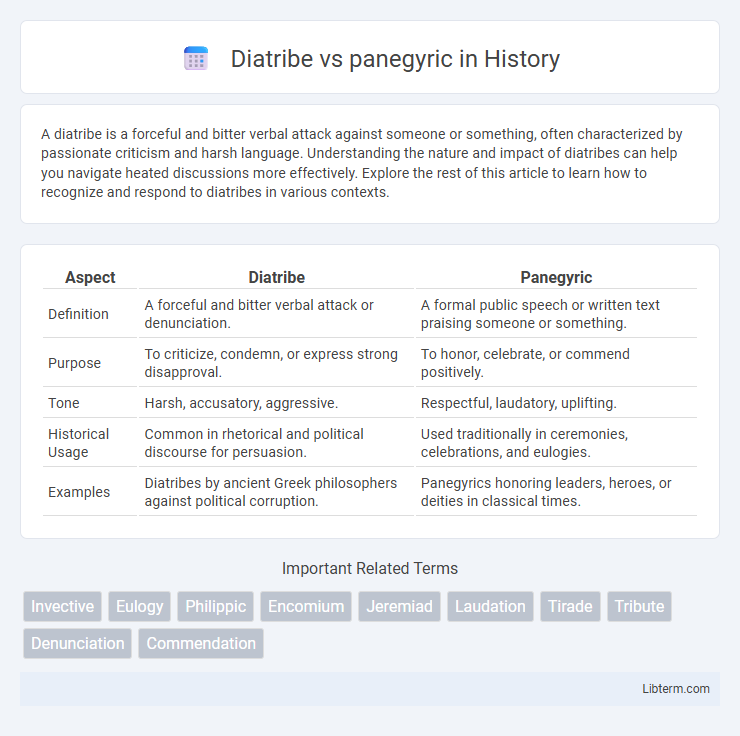A diatribe is a forceful and bitter verbal attack against someone or something, often characterized by passionate criticism and harsh language. Understanding the nature and impact of diatribes can help you navigate heated discussions more effectively. Explore the rest of this article to learn how to recognize and respond to diatribes in various contexts.
Table of Comparison
| Aspect | Diatribe | Panegyric |
|---|---|---|
| Definition | A forceful and bitter verbal attack or denunciation. | A formal public speech or written text praising someone or something. |
| Purpose | To criticize, condemn, or express strong disapproval. | To honor, celebrate, or commend positively. |
| Tone | Harsh, accusatory, aggressive. | Respectful, laudatory, uplifting. |
| Historical Usage | Common in rhetorical and political discourse for persuasion. | Used traditionally in ceremonies, celebrations, and eulogies. |
| Examples | Diatribes by ancient Greek philosophers against political corruption. | Panegyrics honoring leaders, heroes, or deities in classical times. |
Understanding Diatribe and Panegyric
Diatribe is a forceful and bitter verbal attack targeting a person, idea, or institution, often characterized by critical and negative language used to express strong disapproval. Panegyric, by contrast, is a formal public speech or written text that praises someone or something highly, emphasizing positive qualities and achievements through eloquent and laudatory language. Understanding diatribe and panegyric involves recognizing their opposite intentions: diatribe aims to condemn and criticize, while panegyric seeks to honor and celebrate.
Etymology and Historical Origins
Diatribe originates from the Greek word "diatribein," meaning "to spend time," reflecting its roots in extended moral or philosophical discourse dating back to ancient Greece. Panegyric derives from the Greek "paneguris," meaning "a public assembly," evolving into formal speeches praising individuals or events in classical antiquity. Both terms highlight contrasting rhetorical traditions: diatribe's critical and argumentative nature versus panegyric's laudatory and celebratory emphasis.
Key Characteristics of Diatribe
A diatribe is a forceful and bitter verbal attack or criticism aimed at a person, idea, or institution, characterized by its aggressive tone, emotional intensity, and persuasive intent to expose faults or provoke change. It often employs strong language, vivid imagery, and rhetorical questions to highlight perceived injustices or shortcomings. Unlike a panegyric, which is a formal expression of praise, a diatribe serves as a vehicle for condemnation and dissent.
Defining Features of Panegyric
Panegyric is characterized by its formal and elaborate praise, often delivered in public speeches or written texts to honor a person, event, or institution. It employs exalted language, rhetorical flourishes, and positive imagery to highlight virtues, achievements, and admirable qualities. Unlike a diatribe, which criticizes or attacks, panegyric serves to celebrate and elevate its subject through commendation and laudatory expressions.
Major Differences: Tone and Purpose
Diatribe and panegyric differ significantly in tone and purpose, with diatribe characterized by a harsh, critical, and often angry tone aimed at condemning or criticizing a subject, while panegyric adopts a laudatory, celebratory tone to praise and honor someone or something. The primary purpose of a diatribe is to express strong disapproval or to challenge ideas forcefully, contrasting with panegyric's goal of admiration and positive reinforcement. These differences shape how each rhetorical style functions within speeches, literature, and public discourse.
Contexts Where Diatribes Are Common
Diatribes commonly appear in political speeches, social commentaries, and literature where strong criticism or condemnation is necessary to highlight issues such as injustice, corruption, or moral failures. These contexts often involve delivering passionate, aggressive rhetoric aimed at provoking thought or action against perceived wrongdoings. Unlike panegyrics, which praise and celebrate, diatribes serve to challenge and confront controversial subjects through pointed, forceful language.
Occasions for Panegyrics
Panegyrics are delivered during formal ceremonies, such as award presentations, memorial services, and commemorations, where they honor individuals, achievements, or historic events. These speeches emphasize praise and admiration, often highlighting virtues, accomplishments, or contributions that inspire audiences. Unlike diatribes, which critique or condemn, panegyrics serve to celebrate and affirm positive qualities in public and solemn occasions.
Famous Examples in Literature and Speech
Diatribes and panegyrics serve opposite rhetorical purposes, with famous diatribes including Jonathan Swift's "A Modest Proposal," which sharply criticizes social issues through irony and invective. In contrast, panegyrics such as Mark Antony's speech in Shakespeare's "Julius Caesar" laud and praise a person or event, exemplifying eloquent admiration. Both forms remain pivotal in literature and speech for their powerful influence on audiences and cultural discourse.
Impact on Audience Perception
Diatribes, characterized by harsh criticism and aggressive language, often provoke strong emotional reactions, fostering skepticism or hostility toward the subject. Panegyrics, with their laudatory and celebratory tone, tend to enhance admiration and positive perception, reinforcing the subject's virtues. The contrasting rhetorical strategies shape audience engagement by either challenging beliefs or affirming values.
Choosing Between Diatribe and Panegyric
Choosing between diatribe and panegyric depends on the intent and tone desired in communication; a diatribe delivers a forceful, often angry critique aimed at denouncing a subject, while a panegyric offers a formal and enthusiastic praise celebrating achievements or virtues. Effective use of diatribe can highlight societal issues or provoke change through strong emotional appeal, whereas employing a panegyric enhances reputation and motivates through positive reinforcement. Understanding the audience's expectations and the message's purpose ensures the strategic selection of either diatribe's critical intensity or panegyric's laudatory tone.
Diatribe Infographic

 libterm.com
libterm.com